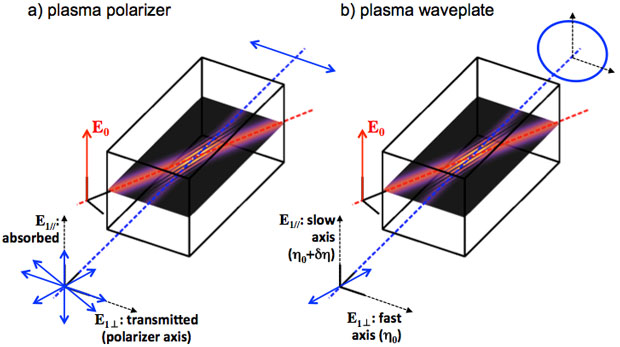Pierre Michel (16-LW-022)
Project Description
Large laser facilities such as Livermore's National Ignition Facility are opening a new era for Inertial Confinement Fusion and high-energy-density science. Their unprecedented laser energies and extreme conditions are creating new venues of laser–matter interaction physics in regimes previously unavailable. At the same time, these facilities present formidable technological challenges because of the complexity of operating high-power lasers with an extreme degree of precision and within constraints set by optics damage thresholds. Laser control at such high powers is usually achieved far away from the target, where the size of the laser beam is greatly increased to reduce the laser flux on the optical elements and avoid destroying them, an approach that drives up the cost and size of these facilities. A different approach consists of controlling the lasers directly in situ, focusing them to a sub-millimeter-size spot at their highest intensities. Matter under such extreme laser fluxes instantly becomes a plasma. This plasma possesses optical properties that can be used to control laser light in many novel ways, reproducing or even surpassing what is achievable in crystal-based optical systems at intensities over a million times higher. With this project, we intend to advance our fundamental understanding of plasma photonics, the science of light manipulation using plasmas, by tailoring the plasma refractive index. The knowledge gained will be applied to new concepts and applications for plasma-based photonics systems and to manipulate laser light in situ, possibly even replacing crystal-based optical systems. These novel solutions for the manipulation of light will benefit current and future generations of laser facilities as well as the science experiments carried out on them.
With what we learn from this study, the manipulation of light by plasmas in extreme conditions, we expect to develop multiple plasma photonics building blocks, and to combine them into progressively more complex systems. One example of such a system would be a plasma-based Pockels cell and optical switch. In principle, this could be developed by combining the two building blocks of a plasma polarizer and wave plate. Besides the resistance to high laser fluxes, these systems should also possess extremely fast response times compared to crystal-based optics systems. Results from our plasma photonics research could contribute significantly to the science and technology associated with the design of the next generation of large-scale, high-power laser systems by offering novel solutions to some of the existing challenges, specifically by the replacement of traditional optics by "indestructable" plasma-based systems. Results of this project could also have a dramatic impact on the Inertial Confinement Fusion and high-energy-density science experiments carried out at these facilities, by allowing manipulation of light directly inside the target.
Mission Relevance
This research supports Livermore's core competency in lasers and optical science and technology through its exploration of novel solutions to some of the existing challenges related to the design of high-power laser systems. This project is also well aligned with the Laboratory's strategic focus area of inertial fusion science and technology, which would benefit from advances to these systems.
FY16 Accomplishments and Results
The scope of this work was extended immediately after the project started, from purely theoretical (proposing new concepts of plasma photonics) to experimental (testing these concepts in laboratory experiments at Livermore's Janus Laser Facility). In FY16 we (1) demonstrated laser-induced plasma birefringence and a "plasma wave plate;" (2) provided the first demonstration of a "plasma polarizer," shown in the figure; (3) tested the concept of a dielectric plasma mirror; and (4) derived a theory describing the establishment of a steady state for the refractive microstructures imprinted by lasers in plasmas, which explains certain experimental results.
Publications and Presentations
- Turnbull, D., et al., "High power dynamic polarization control using plasma photonics." Phys. Rev. Lett. 116, 205001 (2016). LLNL-JRNL-683478. http://dx.doi.org/10.1103/PhysRevLett.116.205001






